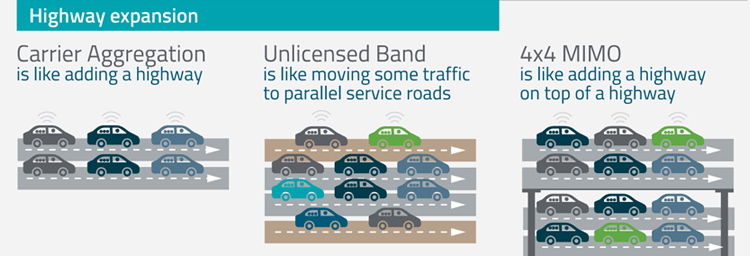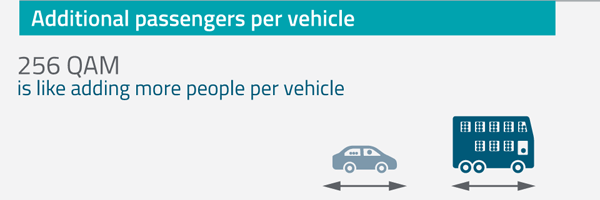LTE Advanced Pro (LTE-A Pro) is the latest version of LTE standard available for businesses to provide incredibly fast data rates. But how much faster is LTE-A Pro compared to previous versions? Well, while previous versions of LTE operated like a highway of information, with small packets of data traveling from one location to the next,
LTE-A Pro operates more like a blisteringly fast, multi-story “superhighway.”
When you choose an LTE-A Pro embedded module for your IoT devices, you’ll see massive increases in data speed, capacity and efficiency. Not only does LTE-A Pro improve the rate at which data travels, it also makes this process more efficient and streamlined, allowing your device to send a greater amount of data at once with much lower latency. As the last 4G technology jump before 5G, LTE-A Pro has a lot of performance advantages.
Harnessing the Power of the “Data Superhighway”

The best way to envision the difference between LTE-A Pro systems and previous versions of LTE is to think of data traveling along a highway. In this analogy, transferring data from one device to another is like traveling in a car from point A to point B. Baseline LTE systems operate like a single highway; a few “passengers” (data) travel along the single highway in a car (data packets). However, this process can be relatively slow, and only allows for one flow of data at a time. By contrast, LTE-A Pro is more like a multi-lane, multi-story superhighway that’s capable of transporting far more data.

As you can see in the image above, LTE-A Pro improves data rate speeds from a number of angles.
First, LTE-A Pro includes carrier aggregation. Using the highway analogy, this is like adding a second, third or even fourth lane to a single highway. By combining more than one frequency into a single data pathway, LTE-A Pro can send a greater volume of data at once. These frequencies are transmitted in parallel, just like lanes on a highway, and can handle up to five carriers at once (with a bandwidth of 20 MHz each). In the future, these limits could expand even further, allowing for additional carriers.
Secondly, LTE-A Pro supports unlicensed bands, which is like adding separate, parallel roads alongside the superhighway. With LTE-A Pro, data can travel on portions of the wireless spectrum that were once completely unavailable to businesses. In the past, businesses were limited to Time Division Duplex and Frequency-Division Duplex bands using LTE-A. With LTE-A Pro, IoT devices can support these two bands, as well as Licensed Assist Access, enhanced LAA and LTE Wi-Fi Aggregation. To use all of these bands, LTE-A Pro simply aggregates the data into a 5 GHz LTE-unlicensed spectrum, which improves speeds.
Finally, LTE-A Pro supports the 4x4 MIMO antenna scheme, which is like adding a second-story, elevated highway right on top of your existing superhighway. Several antennas create more than one pathway on the same channel, dramatically increasing data rate speeds. This means that you can send and receive multiple data signals at the same time, and over the exact same radio channel, improving your throughput and giving you greater range.

Moreover, LTE-A Pro modules can enhance your data capacity through supporting the 256 QAM signal modulation scheme. This would be like replacing every four-passenger car on your superhighway with a line of double-decker buses instead, carrying more data per “vehicle”. In other words, the 256 QAM modulation scheme combines two AM signals into one channel, which doubles the bandwidth for that particular channel. You can carry more information using this extended bandwidth, making much more efficient use out of the spectrum.
How LTE-A Pro Improves Upon Existing Technology
This superhighway analogy illustrates just how essential LTE-A Pro modules will be to enable the world’s fastest IoT applications for mobile computing, networking, and industrial M2M. What also sets LTE-A Pro apart from past versions is its support of Category 16 data rates in the future. What this means is that, in the near future, you will be able to obtain a downlink speed of 1 Gbps, and an uplink speed of 150 Mbps. In other words, with these new advances, you’ll see downlink speeds that are nearly 10 times faster than the original LTE release (which supported only Category 3 data rates). Moreover, you’ll see uplink speeds that are about three times faster than LTE-A (which supported Category 6 rates). We expect to support Category 16 rates by the end of 2018.
LTE-A Pro could improve your IoT devices in a number of ways, from faster data rate speeds to extended bandwidth. But you may not realize that this could also allow you to achieve more efficiency using fewer components. A device that once used six or eight modules may require only two or three modules to do the same job using LTE-A Pro modules. This reduction could lower your cost of operation, while making future device installations much simpler.
How to Use LTE-A Speeds to Your Advantage
Making the transition to LTE-A Pro is a relatively streamlined process with Sierra Wireless’ LTE-A Pro module, which also supports global coverage on a single module, simplifying bill of materials when building devices in multiple regions.. The modules are in a PCI-SIG® M.2 standard form factor, providing plug and play connectivity.
By focusing on the latest LTE advances now, you can achieve peak performance until 5G products are available. To find out more about how LTE-A Pro can benefit your IoT application, read our whitepaper, The Last 4G Technology Jump Before 5G: What LTE-Advanced Pro Means For The IoT. Then, Start with Sierra to make your company’s goals a reality.




